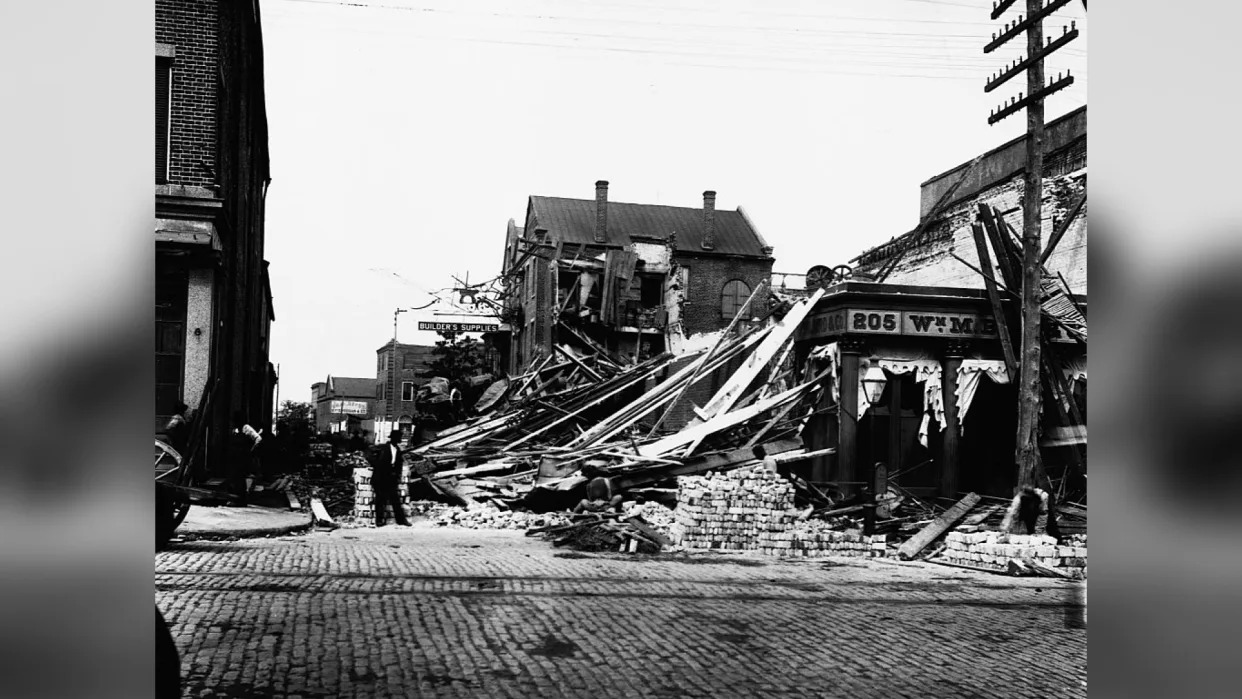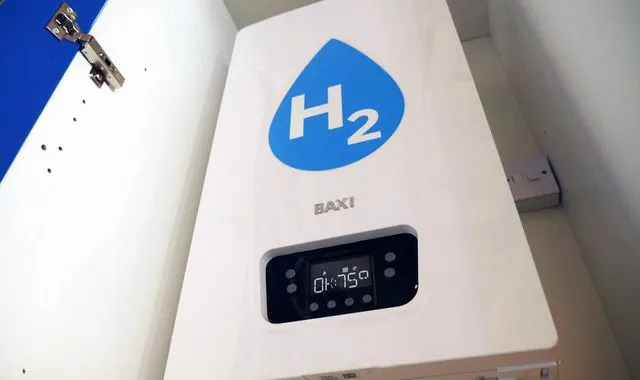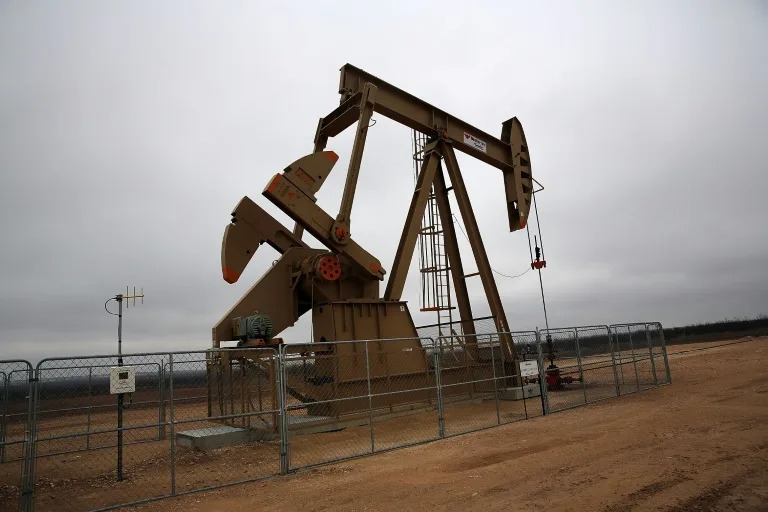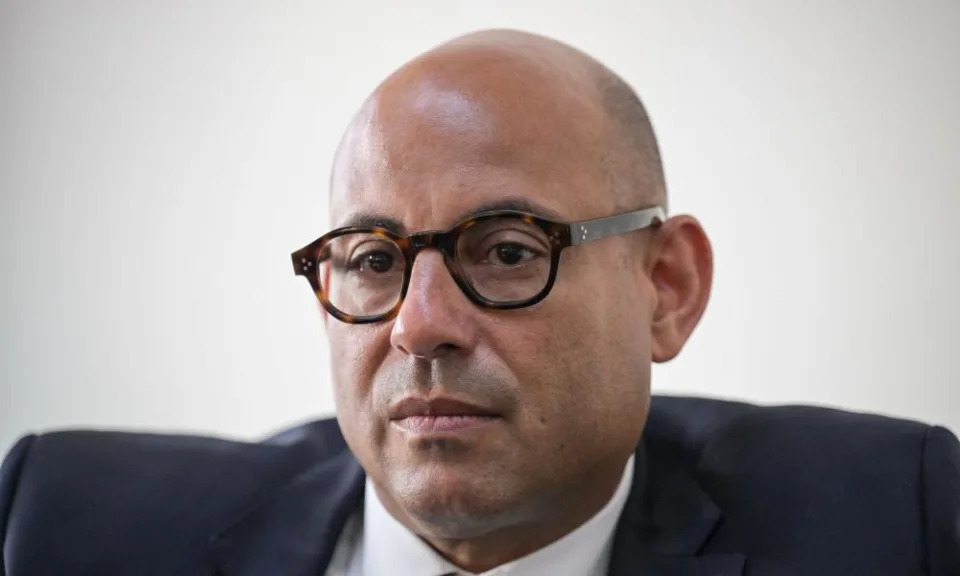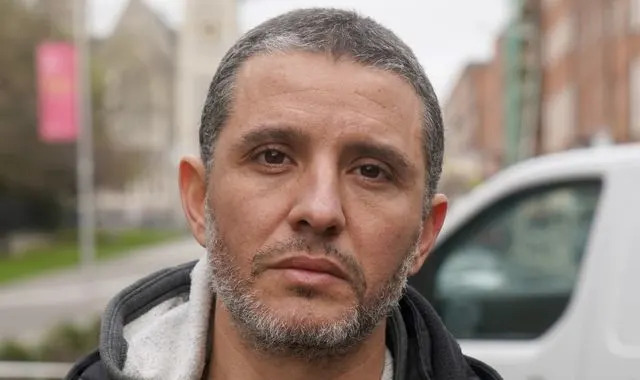Manual drilling likely in last stretch to rescue 41 trapped workers in Indian tunnel
Sat, November 25, 2023

Tunnel where workers are trapped following a collapse in Uttarkashi, in the northern state of Uttarakhand
By Saurabh Sharma
SILKYARA, India (Reuters) - Efforts to rescue 41 workers trapped in a highway tunnel in the Indian Himalayas for two weeks will be further slowed as rescuers are considering drilling through the last 10 meters of debris manually, an official said on Saturday.
The heavy drill machine being used to break through the nearly 60 meters of debris was damaged on Friday and needs to be pulled out entirely, according to an official statement.
The men, construction workers from some of India's poorest states, have been stuck in the 4.5-km (3-mile) tunnel being built in Uttarakhand state since it caved in early on Nov. 12. Authorities have said they are safe, with access to light, oxygen, food, water and medicines.
A senior official involved in the rescue mission told Reuters that since the damaged machine cannot be used, they are planning to cut through the remaining debris manually.
The drill machine, called an auger, was damaged as it was being pulled out of the nearly 47-meter pipe inserted to bring out the trapped workers, after hitting an obstacle on Friday.
The machine broke at a joint and some parts are being cut so it can be pulled from the tunnel. Once it has been removed, drilling will be done manually, the official said.
Sunita Hembrom, who spoke to her trapped brother-in-law Birendra Kishku, 39, said that "everyone trapped inside is very worried".
"My brother in law told me that he has hasn't eaten any food since yesterday. We are very worried," she said.
Authorities have not said what caused the tunnel collapse, but the region is prone to landslides, earthquakes and floods.
The tunnel did not have an emergency exit and was built through a geological fault, a member of a panel of experts investigating the disaster said on Friday on condition of anonymity as they are not authorised to speak to media.
The rescue plan involves pushing a pipe wide enough to pull the trapped men out on wheeled stretchers. Rescue workers rehearsed the evacuation by going into the pipe and being pulled out on stretchers, a video clip provided by the authorities showed.
A second plan to drill vertically from atop the hill is also being pursued and the drilling machines are being assembled, the statement said.
The men have been getting cooked food since a larger lifeline pipe was pushed through earlier this week and the statement said they were sent 200 rotis or Indian round flat bread, lentils and vegetable curry.
More than a dozen doctors, including psychiatrists, have been at the site, talking to the men and monitoring their health.
They have been advised to do light yoga exercises, walk around in the 2-km space they have been confined to, and to keep speaking to each other. Rohit Gondwal, a psychiatrist, said they were also considering sending in playing cards and board games.
The collapsed tunnel is on the Char Dham pilgrimage route, one of the most ambitious projects of Prime Minister Narendra Modi's government.
It aims to link four key Hindu pilgrimage sites with 890 km (550 miles) of two-lane road, at a cost of $1.5 billion.
(Reporting by Saurabh Sharma in Silkyara; Writing by Krishn Kauhsik; Editing by Jacqueline Wong)
Sat, November 25, 2023

Tunnel where workers are trapped following a collapse in Uttarkashi, in the northern state of Uttarakhand
By Saurabh Sharma
SILKYARA, India (Reuters) - Efforts to rescue 41 workers trapped in a highway tunnel in the Indian Himalayas for two weeks will be further slowed as rescuers are considering drilling through the last 10 meters of debris manually, an official said on Saturday.
The heavy drill machine being used to break through the nearly 60 meters of debris was damaged on Friday and needs to be pulled out entirely, according to an official statement.
The men, construction workers from some of India's poorest states, have been stuck in the 4.5-km (3-mile) tunnel being built in Uttarakhand state since it caved in early on Nov. 12. Authorities have said they are safe, with access to light, oxygen, food, water and medicines.
A senior official involved in the rescue mission told Reuters that since the damaged machine cannot be used, they are planning to cut through the remaining debris manually.
The drill machine, called an auger, was damaged as it was being pulled out of the nearly 47-meter pipe inserted to bring out the trapped workers, after hitting an obstacle on Friday.
The machine broke at a joint and some parts are being cut so it can be pulled from the tunnel. Once it has been removed, drilling will be done manually, the official said.
Sunita Hembrom, who spoke to her trapped brother-in-law Birendra Kishku, 39, said that "everyone trapped inside is very worried".
"My brother in law told me that he has hasn't eaten any food since yesterday. We are very worried," she said.
Authorities have not said what caused the tunnel collapse, but the region is prone to landslides, earthquakes and floods.
The tunnel did not have an emergency exit and was built through a geological fault, a member of a panel of experts investigating the disaster said on Friday on condition of anonymity as they are not authorised to speak to media.
The rescue plan involves pushing a pipe wide enough to pull the trapped men out on wheeled stretchers. Rescue workers rehearsed the evacuation by going into the pipe and being pulled out on stretchers, a video clip provided by the authorities showed.
A second plan to drill vertically from atop the hill is also being pursued and the drilling machines are being assembled, the statement said.
The men have been getting cooked food since a larger lifeline pipe was pushed through earlier this week and the statement said they were sent 200 rotis or Indian round flat bread, lentils and vegetable curry.
More than a dozen doctors, including psychiatrists, have been at the site, talking to the men and monitoring their health.
They have been advised to do light yoga exercises, walk around in the 2-km space they have been confined to, and to keep speaking to each other. Rohit Gondwal, a psychiatrist, said they were also considering sending in playing cards and board games.
The collapsed tunnel is on the Char Dham pilgrimage route, one of the most ambitious projects of Prime Minister Narendra Modi's government.
It aims to link four key Hindu pilgrimage sites with 890 km (550 miles) of two-lane road, at a cost of $1.5 billion.
(Reporting by Saurabh Sharma in Silkyara; Writing by Krishn Kauhsik; Editing by Jacqueline Wong)
Agonising wait for rescue of Indian tunnel workers goes on as drill breaks down on final stretch
Shweta Sharma
Fri, November 24, 2023
The operation to rescue 41 men trapped in a collapsed tunnel in India’s Uttarakhand state has been delayed again despite reaching the final stages after a drilling machine developed a snag.
The low-wage construction workers remained trapped for the 13th day as efforts to rescue them have been delayed by hurdles.
The rescue operation reached its final stages on Thursday but had to be suspended after a drilling machine hit an iron mesh of lattice girder – a collapsed structural element of the tunnel.
The platform on which the auger drilling machine was fixed was damaged and needed to be repaired, Deepak Patil, who is heading the rescue operation, said.
It forced the team to clear the path manually with gas-cutters, delaying the work by around six hours.
The latest rescue action bulletin by the authorities said the fresh push to insert the pipe started on Friday morning and the pipe reached an additional 1.8m.
But the auger was “pushed slightly back” after a minor vibration was noted in the collapsed structure. An estimated 15m (49ft) of the debris pile is left to be drilled through and a study using ground penetration radar shows there is no metallic obstruction for the next 5m, said Bhaskar Khulbe, a senior tunnel project official.
The bulletin said drilling with the auger machine would start after the welder’s team would manually cut the bent pipe obstructing the drilling.
Australian tunneling expert Arnold Dix, who arrived in India to assist with the rescue work, said the machine has broken down three times and it will be repaired by Friday morning.
“We are only just metres away from finding passage to have the men back. But the men are safe. The auger machine has broken down, it is being repaired and it should be back up tomorrow. The drilling machine has broken down three times,” he told ANI.
He said he was disappointed but not upset as men are safe and said “the men are coming out” in any case.
A part of the 4.5km (3 miles) Silkyara tunnel in Uttarakhand collapsed on 12 November in a landslide. A communication line was established with the trapped workers following the collapse and have been supplying food, water, snacks and oxygen through a pipeline that was laid for supplying water for the construction work.
On Tuesday, the first visuals of the 41 trapped workers emerged after an endoscopic camera was sent through a pipe which captured the workers’ first images since 12 November.
Authorities planned to retrieve the men by creating a micro-tunnel by sending multiple pipes. The width of the debris is estimated to be 60m (197ft) through which the rescue workers have to pass the pipes.
Meanwhile, anticipation has been building in the families of the trapped workers.
A family member of worker Sushil Sharma said he spoke with him on Friday morning and they are doing fine.
“Everyone is fine inside, and there are facilities. I asked him if he was facing any difficulties, and he said that there were no difficulties,” Haridwar Sharma told ANI.
“They are all just hoping to come out soon. Everything is available there... There is a facility for bathing too... I said that you would surely get out.”
The collapse of the tunnel in a region already prone to landslides has sparked debate among environmentalists about the damaging impact of construction projects in the already fragile Himalayas.
It was part of the Char Dham pilgrimage route, one of the most ambitious infrastructure projects of Indian prime minister Narendra Modi’s Hindu nationalist government, which aims to connect four Hindu pilgrimage sites in the mountains through 890km (550 miles) of roads at a cost of $1.5bn (£1.2bn).
Digging to rescue 41 workers trapped in a collapsed tunnel in India halted after machine breaks
Associated Press
Sat, November 25, 2023
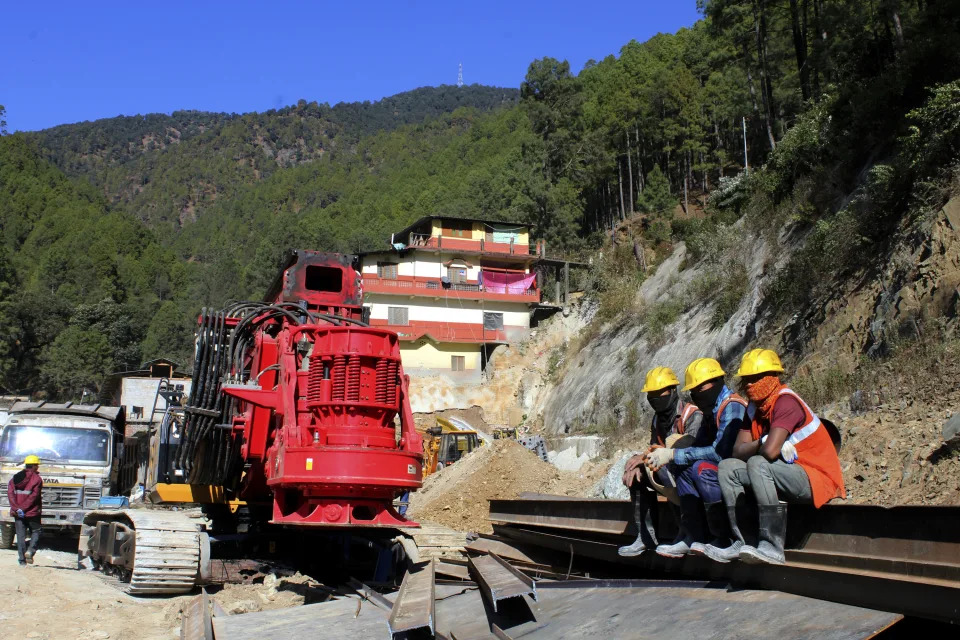
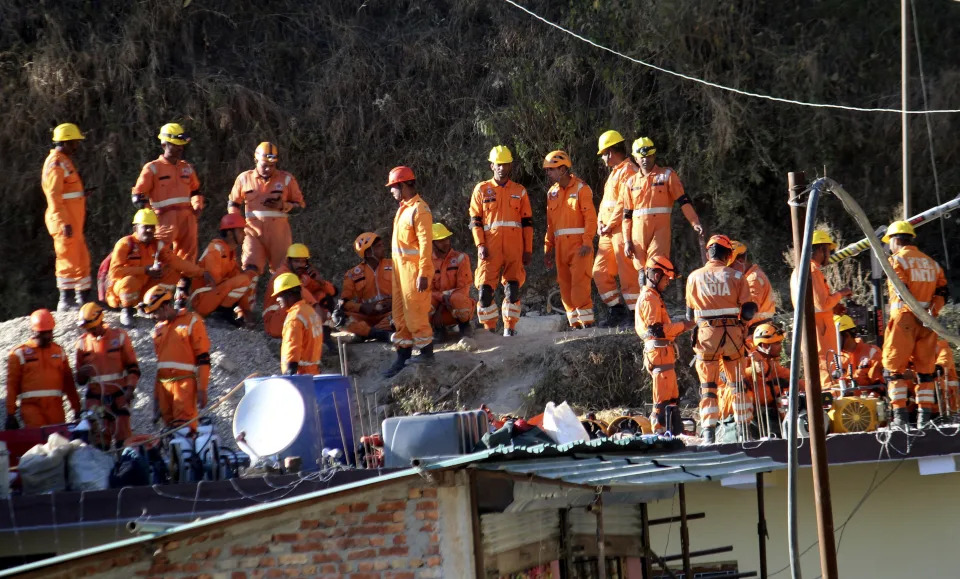
Rescuers rest at the site of an under-construction road tunnel that collapsed in Silkyara in the northern Indian state of Uttarakhand, Friday, Nov. 24, 2023. Rescuers are racing to evacuate 41 construction workers who have been trapped for nearly two weeks.
(AP Photo)
NEW DELHI (AP) — Attempts to reach 41 construction workers stuck in a collapsed tunnel in northern India for two weeks were again stymied Saturday.
Rescuers had been working by hand to remove debris after the drilling machine they were using broke down a day earlier while making its way through the debris of rock, stones and metal, but the operation was halted on Saturday.
Arnold Dix, an international expert assisting the rescue team at the accident site in Uttarakhand state, said it is unclear when the drilling will be able to start again.
“The machine is busted. It is irreparable,” he told reporters. “The mountain has once again resisted the auger (machine).”
The workers have been trapped since Nov. 12 when a landslide caused a portion of the 4.5-kilometer (2.8-mile) tunnel they were building to collapse about 200 meters (650 feet) from the entrance. The mountainous terrain in the area has proven to be a challenge for the drilling machine, which had earlier broken twice as rescue teams attempted to dig horizontally toward the trapped workers.
The machine stopped working after it had drilled about 2 meters (6.5 feet) of the last stretch of 12 meters (40 feet) of rock debris that would open a passage for the workers to come out from the tunnel.
Rescuers have inserted pipes into the dug-out channel and welded them together to serve as a passageway from where the men would be pulled out on wheeled stretchers. About 46 meters (151 feet) of pipe has been put in so far, according to Devendra Patwal, a disaster management officer.
Meanwhile, a new drilling machine used to dig vertically was brought to the accident site Saturday.
The vertical dig is seen as an alternative plan to reach the trapped men, and the rescuers have already created an access road to the top of the hill. However, rescue teams will need to dig 103 meters (338 feet) downward to reach the trapped workers — nearly double the distance of the horizontal shaft.
Authorities have supplied the trapped workers with hot meals made of rice and lentils through a 6-inch (15-centimeter) pipe after days when they survived on dry food sent through a narrower pipe. Oxygen is being supplied through a separate pipe, and more than a dozen doctors, including psychiatrists, have been at the accident site monitoring their health.
Most of the trapped workers are migrant laborers from across the country. Many of their families have traveled to the accident site, where they have camped out for days to get updates on the rescue effort and in hopes of seeing their relatives soon.
The tunnel the workers were building was designed as part of the Chardham all-weather road, which will connect various Hindu pilgrimage sites. Some experts say the project, a flagship initiative of the federal government, will exacerbate fragile conditions in the upper Himalayas, where several towns are built atop landslide debris.
Large numbers of pilgrims and tourists visit Uttarakhand’s many Hindu temples, with the number increasing over the years due to the continued construction of buildings and roadways.
NEW DELHI (AP) — Attempts to reach 41 construction workers stuck in a collapsed tunnel in northern India for two weeks were again stymied Saturday.
Rescuers had been working by hand to remove debris after the drilling machine they were using broke down a day earlier while making its way through the debris of rock, stones and metal, but the operation was halted on Saturday.
Arnold Dix, an international expert assisting the rescue team at the accident site in Uttarakhand state, said it is unclear when the drilling will be able to start again.
“The machine is busted. It is irreparable,” he told reporters. “The mountain has once again resisted the auger (machine).”
The workers have been trapped since Nov. 12 when a landslide caused a portion of the 4.5-kilometer (2.8-mile) tunnel they were building to collapse about 200 meters (650 feet) from the entrance. The mountainous terrain in the area has proven to be a challenge for the drilling machine, which had earlier broken twice as rescue teams attempted to dig horizontally toward the trapped workers.
The machine stopped working after it had drilled about 2 meters (6.5 feet) of the last stretch of 12 meters (40 feet) of rock debris that would open a passage for the workers to come out from the tunnel.
Rescuers have inserted pipes into the dug-out channel and welded them together to serve as a passageway from where the men would be pulled out on wheeled stretchers. About 46 meters (151 feet) of pipe has been put in so far, according to Devendra Patwal, a disaster management officer.
Meanwhile, a new drilling machine used to dig vertically was brought to the accident site Saturday.
The vertical dig is seen as an alternative plan to reach the trapped men, and the rescuers have already created an access road to the top of the hill. However, rescue teams will need to dig 103 meters (338 feet) downward to reach the trapped workers — nearly double the distance of the horizontal shaft.
Authorities have supplied the trapped workers with hot meals made of rice and lentils through a 6-inch (15-centimeter) pipe after days when they survived on dry food sent through a narrower pipe. Oxygen is being supplied through a separate pipe, and more than a dozen doctors, including psychiatrists, have been at the accident site monitoring their health.
Most of the trapped workers are migrant laborers from across the country. Many of their families have traveled to the accident site, where they have camped out for days to get updates on the rescue effort and in hopes of seeing their relatives soon.
The tunnel the workers were building was designed as part of the Chardham all-weather road, which will connect various Hindu pilgrimage sites. Some experts say the project, a flagship initiative of the federal government, will exacerbate fragile conditions in the upper Himalayas, where several towns are built atop landslide debris.
Large numbers of pilgrims and tourists visit Uttarakhand’s many Hindu temples, with the number increasing over the years due to the continued construction of buildings and roadways.
Uttarakhand tunnel collapse: Machine repairs prolong ordeal for trapped Indians
BBC
Fri, November 24, 2023

The rescue operation has been delayed several times
Rescue work to save 41 workers trapped in a tunnel in India's Uttarakhand state has been delayed again because of a problem with the drilling machine.
The US-made machine is being used to drill through the debris to create an escape route for the workers.
Officials say the machine is being repaired and that drilling work is likely to restart on Friday.
The workers have been stuck inside the tunnel for 12 days after a portion of it collapsed due to a landslide.
A section of the 4.5km (3 miles) Silkyara tunnel in the Indian Himalayas caved in on 12 November.
Contact was established with the trapped men shortly thereafter, and they have been receiving oxygen, food, and water ever since.
Rescuers to drill new tunnels for trapped India workers
The unfolding drama of India's tunnel rescue mission
Rescue officials had earlier announced that they would be able to extricate the men by Thursday morning. But the operations have been delayed after the latest technical glitch.
Bhaskar Khulbe, a former advisor to the prime minister's office actively involved in the rescue operations, told the media that the platform supporting the drilling machine had weakened, requiring an entire night of repairs throughout Thursday.
On Friday, a government release said that the platform of the machine had been reinforced using concrete and that the machine would be reassembled shortly.
The machine is drilling a hole into a 60m (197ft) debris wall that is preventing the workers from escaping the tunnel.
Authorities have been working to send multiple pipes of differing widths through the debris to create a micro-tunnel through which the workers can be brought out.
The plan is to wheel the workers out on stretchers through the pipes.
But the operation is a challenging one due to the presence of rocks, stones and metal inside the debris.
The operation was stalled on Wednesday too after workers encountered a thick metal rod which had to be cut using gas cutters.
Rescuers have drilled through about three-quarters of the debris so far, but it's unclear how long it will take for them to dig through the remaining part.

Rescuers are working on multiple plans to reach the workers
Speaking to reporters on Thursday, Lieutenant General Syed Ata Hasnain, a member of the National Disaster Response Force, said it was "difficult to put a timeline on such a complex operation".
"A lot of it depends on what the rescuers encounter while drilling through the debris," he said.
Arnold Dix, a tunnelling expert helping with the rescue work told reporters, that the machine had broken down thrice during the days-long rescue operations.
"We're the length of a bus away [from the trapped men]," he said. "We were hoping to see them this morning but it looks like the mountain has different ideas," he said.
The mountainous area is also prone to landslides and earthquakes, which is further hampering rescue efforts.
In the meantime, ambulances have been kept on standby outside the tunnel. Officials say the aim is to pull the workers out to safety and shift them to the nearby hospital as quickly as possible.

India - Uttarakhand map
Race to rescue 41 Indian workers trapped inside tunnel is delayed again
Michael Dorgan
Fri, November 24, 2023

Race to rescue 41 Indian workers trapped inside tunnel is delayed again
A frantic battle to rescue 41 construction workers trapped in a tunnel in northern India has faced fresh delays due to a problem with a drilling machine, with officials warning that the next 24 hours could be critical to their chances of survival.
The workers have been trapped beneath a collapsed road tunnel in the Uttarkashi district of India's Uttarakhand state for 12 days after a portion of it collapsed due to a landslide.
The platform on which the U.S.-made auger machine has been mounted became destabilized after developing cracks, according to the Times of India.
The 25-ton platform is being reinforced with concrete with drilling expected to resume later on Friday.

A crane carries a part of a drilling machine being used to rescue construction workers in India. The platform on which the U.S.-made Auger machine has been mounted became destabilized after developing cracks.
The machine is being used to drill through the debris in order to create an escape route consisting of a tunnel of pipes welded together. Once it is in place, rescue teams hope the workers can escape to freedom.
The plan is to wheel the workers out on stretchers through the pipes, according to the BBC.
The auger machine has a drilling capacity of up to 16 feet per hour and is equipped with a 2.9-foot diameter pipe to clear debris. At times, drilling is slowed down by the pile of rubble.
Rescue teams are required to drill down about 195 feet to reach the trapped workers. They are currently about 30 feet away and in the final phase of the operation.

Rescue personnel prepare to enter the tunnel.
The construction workers have been trapped since Nov. 12 when a landslide caused a portion of the 2.7-mile Silkyara tunnel they were building to collapse about 500 feet from the entrance. The hilly area is prone to landslide and subsidence.
The workers had been helping to construct a section of a 424-mile road connecting various Hindu pilgrimage sites in the area. The mountainous topography has several Hindu temples that attract pilgrims and tourists.
Shortly after the collapse, rescue personnel were able to establish contact with the workers, and they have been able to send them oxygen, food and water.

A view of the entrance to the collapsed tunnel in the Uttarkashi district of India's Uttarakhand state. Rescue efforts have been delayed due to a problem with a drilling machine.
It is the latest setback in the rescue operation.
The operation was stalled on Wednesday after workers encountered a thick metal rod, which had to be cut using gas cutters, the BBC reported.
Officials commandeered the U.S. machine last week after the initial one they were using was too slow at pushing through the debris.
The Associated Press contributed to this report.
Rescuers in India trying to evacuate 41 workers from a collapsed tunnel are delayed again
Associated Press
Updated Fri, November 24, 2023

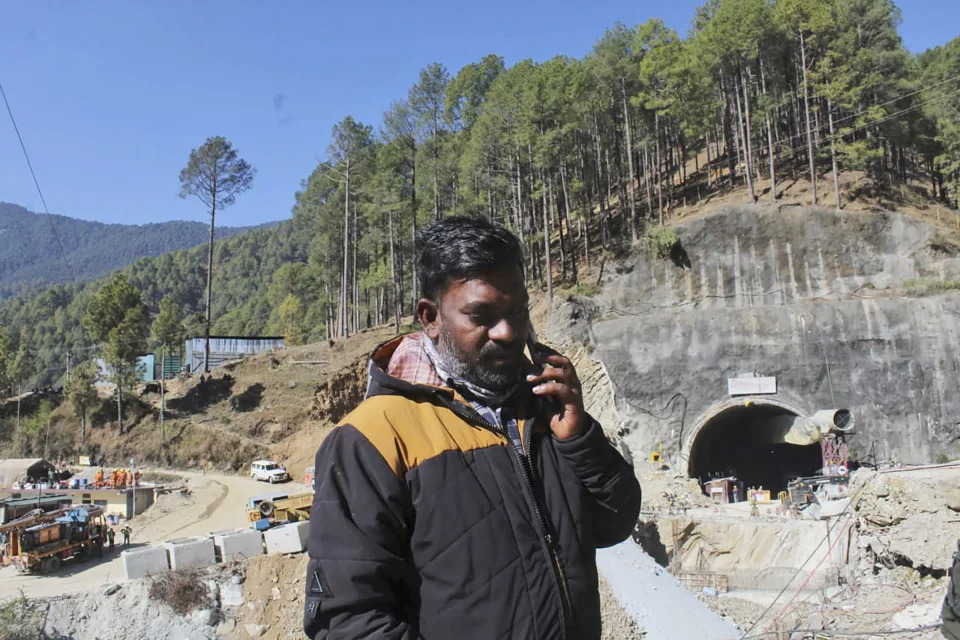
Rescuers rest at the site of an under-construction road tunnel that collapsed in Silkyara in the northern Indian state of Uttarakhand, Friday, Nov. 24, 2023. Rescuers are racing to evacuate 41 construction workers who have been trapped for nearly two weeks
Associated Press
Updated Fri, November 24, 2023


Rescuers rest at the site of an under-construction road tunnel that collapsed in Silkyara in the northern Indian state of Uttarakhand, Friday, Nov. 24, 2023. Rescuers are racing to evacuate 41 construction workers who have been trapped for nearly two weeks
. (AP Photo)
UTTARKASHI, India (AP) — Rescue teams trying to reach 41 construction workers trapped in a collapsed tunnel in northern India for nearly two weeks stopped drilling again Friday after their boring machine hit a new metal obstruction in rock debris, further delaying efforts.
Devendra Patwal, a disaster management officer, said it may take the rescuers several hours to cut the metal object and resume the final phase of digging at the accident site in Uttarakhand state.
Patwal said the machine was stopped after it had drilled about 2 meters (6.5 feet) of the last stretch of 12 meters (40 feet) of rock debris that would open a passage for the trapped workers to come out.
On Thursday, the platform of the machine became unstable while boring and halted the digging, said Kirti Panwar, a Uttarakhand state government spokesman. It resumed drilling Friday evening, Panwar said.
Panwar could not say how long it would take to complete the drilling and to bring the construction workers out. They have been trapped since Nov. 12, when a landslide caused a portion of the 4.5-kilometer (2.8-mile) tunnel they were building to collapse about 200 meters (650 feet) from the entrance.
As the rescue operation stretched into the 13th day, teams had drilled through 46 meters (151 feet) and needed to excavate up to 12 meters (40 feet) more to create a passageway, Panwar said.
Before the work resumed Friday, rescuers manually dug through debris to remove pieces of metal and prevent further damage, he said.
The rescue teams also are inserting pipes into the dug-out channel and welding them together to serve as a passageway. About 46 meters (151 feet) of pipe has been put in so far, according to Panwar. Members of the National Disaster Response Force plan to bring the workers out one by one on stretchers that have been fitted with wheels.
The mountainous terrain in the area has proven to be a challenge for the drilling machine, which broke down last weekend as rescue teams attempted to dig horizontally toward the trapped workers. The machine’s high-intensity vibrations also caused more debris to fall.
The drilling had to stop again on Wednesday after the boring machine hit a metal girder, causing some damage to its blades.
Authorities have supplied the trapped workers with hot meals made of rice and lentils through a 6-inch (15-centimeter) pipe after days of surviving on dry food sent through a narrower pipe. Oxygen is being supplied through a separate pipe.
Most of the trapped workers are migrant laborers from across the country. Many of their families have traveled to the accident site, where they have camped out for days to get updates on the rescue effort and in hopes of seeing their relatives soon.
“We are all waiting here, hoping they come out,” Haridwar Sharma, whose brother, Sushil, is among the workers, said. “It is not in our hands ... the administration is at it, the machinery is there. With God’s blessing, we are hopeful.”
Officials earlier released a video from a camera pushed through the pipe that showed the workers in their construction hats moving around the blocked tunnel while communicating with rescuers on walkie-talkies.
The tunnel the workers were building was designed as part of the Chardham all-weather road, which will connect various Hindu pilgrimage sites. Some experts say the project, a flagship initiative of the federal government, will exacerbate fragile conditions in the upper Himalayas, where several towns are built atop landslide debris.
Large numbers of pilgrims and tourists visit Uttarakhand's many Hindu temples, with the number increasing over the years due to the continued construction of buildings and roadways.
UTTARKASHI, India (AP) — Rescue teams trying to reach 41 construction workers trapped in a collapsed tunnel in northern India for nearly two weeks stopped drilling again Friday after their boring machine hit a new metal obstruction in rock debris, further delaying efforts.
Devendra Patwal, a disaster management officer, said it may take the rescuers several hours to cut the metal object and resume the final phase of digging at the accident site in Uttarakhand state.
Patwal said the machine was stopped after it had drilled about 2 meters (6.5 feet) of the last stretch of 12 meters (40 feet) of rock debris that would open a passage for the trapped workers to come out.
On Thursday, the platform of the machine became unstable while boring and halted the digging, said Kirti Panwar, a Uttarakhand state government spokesman. It resumed drilling Friday evening, Panwar said.
Panwar could not say how long it would take to complete the drilling and to bring the construction workers out. They have been trapped since Nov. 12, when a landslide caused a portion of the 4.5-kilometer (2.8-mile) tunnel they were building to collapse about 200 meters (650 feet) from the entrance.
As the rescue operation stretched into the 13th day, teams had drilled through 46 meters (151 feet) and needed to excavate up to 12 meters (40 feet) more to create a passageway, Panwar said.
Before the work resumed Friday, rescuers manually dug through debris to remove pieces of metal and prevent further damage, he said.
The rescue teams also are inserting pipes into the dug-out channel and welding them together to serve as a passageway. About 46 meters (151 feet) of pipe has been put in so far, according to Panwar. Members of the National Disaster Response Force plan to bring the workers out one by one on stretchers that have been fitted with wheels.
The mountainous terrain in the area has proven to be a challenge for the drilling machine, which broke down last weekend as rescue teams attempted to dig horizontally toward the trapped workers. The machine’s high-intensity vibrations also caused more debris to fall.
The drilling had to stop again on Wednesday after the boring machine hit a metal girder, causing some damage to its blades.
Authorities have supplied the trapped workers with hot meals made of rice and lentils through a 6-inch (15-centimeter) pipe after days of surviving on dry food sent through a narrower pipe. Oxygen is being supplied through a separate pipe.
Most of the trapped workers are migrant laborers from across the country. Many of their families have traveled to the accident site, where they have camped out for days to get updates on the rescue effort and in hopes of seeing their relatives soon.
“We are all waiting here, hoping they come out,” Haridwar Sharma, whose brother, Sushil, is among the workers, said. “It is not in our hands ... the administration is at it, the machinery is there. With God’s blessing, we are hopeful.”
Officials earlier released a video from a camera pushed through the pipe that showed the workers in their construction hats moving around the blocked tunnel while communicating with rescuers on walkie-talkies.
The tunnel the workers were building was designed as part of the Chardham all-weather road, which will connect various Hindu pilgrimage sites. Some experts say the project, a flagship initiative of the federal government, will exacerbate fragile conditions in the upper Himalayas, where several towns are built atop landslide debris.
Large numbers of pilgrims and tourists visit Uttarakhand's many Hindu temples, with the number increasing over the years due to the continued construction of buildings and roadways.
14 metres to freedom: Final push to free Indian tunnel workers
Jalees ANDRABI
Fri, November 24, 2023
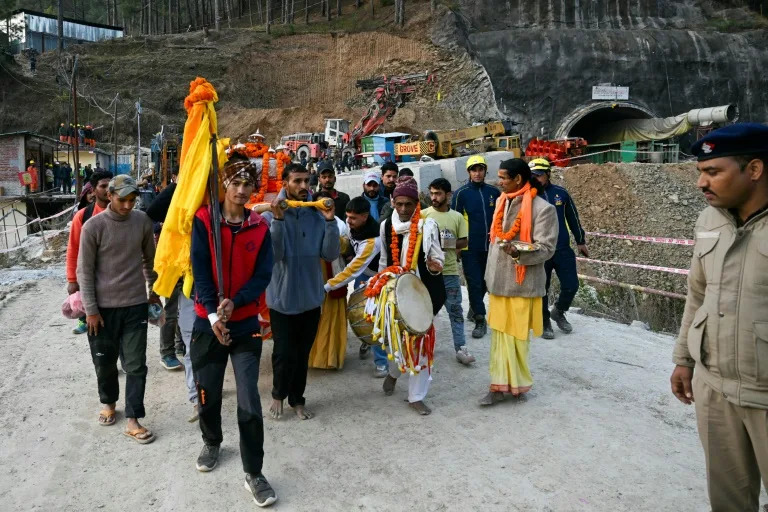
Prayers have been held for the local Hindu deity Boukhnag for the safe release of the trapped workers (Arun SANKAR)
Just a few metres of rock and earth separate Indian rescue teams from 41 workers who have been trapped inside a collapsed road tunnel for nearly two weeks, officials said Friday, vowing to get all the men out safely.
After a series of rapid advances, hopes that the men's freedom was imminent were dashed late Wednesday when the drilling machine powering through tonnes of rock and concrete ran into metal rods, but those have now been cleared.
An AFP reporter could see sparks flying as workers in the entrance of the tunnel welded together the final sections of steel pipe, to make the tube that will provide a safe exit for the trapped workers.
Rescue teams have stretchers fitted with wheels ready to pull the exhausted men through 57 metres (187 feet) of pipe once it has been driven through the final section of rubble blocking their escape.
"We have to (drill) 14 metres further inside the tunnel," Bhaskar Khulbe, a senior government official overseeing rescue efforts, told reporters on Friday, adding that the "trapped workers are in good frame of mind".
Officials have repeatedly predicted they were within a few hours of a breakthrough, but a government statement has also noted that any timeline is "subject to change due to technical glitches, the challenging Himalayan terrain, and unforeseen emergencies".
Ambulances are on standby and a field hospital has been prepared to receive the men, who have been trapped since a portion of the under-construction Silkyara tunnel in the Himalayan state of Uttarakhand caved in 13 days ago.
- 'Get these brave men out' -
Syed Ata Hasnain, a senior rescue official and retired general, said their efforts were "like battle".
"By any means, we must get these brave men out", he told reporters on Friday afternoon, adding that "all resources" needed were being utilised.
"This is a war that is being fought to save the sons of India who have been toiling up there in the mountains," Hasnain said, adding that the final stretch was critical.
"We are going to be very, very careful in further progress", he said.
The area outside the tunnel has been a flurry of activity, with worried relatives gathering and rescue teams stopping to pray at a Hindu shrine erected at the entrance.
National Disaster Response Force chief Atul Karwal said his teams had been rehearsing how -- once the steel pipe breaks through -- they would bring the men out as quickly and safely as possible.
"The boys will go in first," he said Thursday. "We have put wheels under the stretchers so that when we go in, we can get the people out one by one on the stretcher -- we are prepared in every way."
Rescue efforts have been hit with repeated delays caused by falling debris, fears of further cave-ins and drilling machine breakdowns.
Arnold Dix, president of the International Tunnelling and Underground Space Association, who is at the site assisting the rescue, said engineers had even faced having to cut through construction vehicles buried in the earth when the roof first collapsed.
Uttarakhand chief minister Pushkar Singh Dhami said work was on a "war footing".
"We are trying to overcome all the obstacles soon, and bring all the workers out safely," Dhami said Friday.
bur-pjm/leg
Race to rescue 41 Indian workers trapped inside tunnel is delayed again
Michael Dorgan
Fri, November 24, 2023

Race to rescue 41 Indian workers trapped inside tunnel is delayed again
A frantic battle to rescue 41 construction workers trapped in a tunnel in northern India has faced fresh delays due to a problem with a drilling machine, with officials warning that the next 24 hours could be critical to their chances of survival.
The workers have been trapped beneath a collapsed road tunnel in the Uttarkashi district of India's Uttarakhand state for 12 days after a portion of it collapsed due to a landslide.
The platform on which the U.S.-made auger machine has been mounted became destabilized after developing cracks, according to the Times of India.
The 25-ton platform is being reinforced with concrete with drilling expected to resume later on Friday.

A crane carries a part of a drilling machine being used to rescue construction workers in India. The platform on which the U.S.-made Auger machine has been mounted became destabilized after developing cracks.
The machine is being used to drill through the debris in order to create an escape route consisting of a tunnel of pipes welded together. Once it is in place, rescue teams hope the workers can escape to freedom.
The plan is to wheel the workers out on stretchers through the pipes, according to the BBC.
The auger machine has a drilling capacity of up to 16 feet per hour and is equipped with a 2.9-foot diameter pipe to clear debris. At times, drilling is slowed down by the pile of rubble.
Rescue teams are required to drill down about 195 feet to reach the trapped workers. They are currently about 30 feet away and in the final phase of the operation.

Rescue personnel prepare to enter the tunnel.
RAILROAD BRIDGE PLATFORM COLLAPSE LEAVES AT LEAST 26 VICTIMS DEAD, OTHERS INJURED
The construction workers have been trapped since Nov. 12 when a landslide caused a portion of the 2.7-mile Silkyara tunnel they were building to collapse about 500 feet from the entrance. The hilly area is prone to landslide and subsidence.
The workers had been helping to construct a section of a 424-mile road connecting various Hindu pilgrimage sites in the area. The mountainous topography has several Hindu temples that attract pilgrims and tourists.
Shortly after the collapse, rescue personnel were able to establish contact with the workers, and they have been able to send them oxygen, food and water.

A view of the entrance to the collapsed tunnel in the Uttarkashi district of India's Uttarakhand state. Rescue efforts have been delayed due to a problem with a drilling machine.
It is the latest setback in the rescue operation.
The operation was stalled on Wednesday after workers encountered a thick metal rod, which had to be cut using gas cutters, the BBC reported.
Officials commandeered the U.S. machine last week after the initial one they were using was too slow at pushing through the debris.
The Associated Press contributed to this report.
'Like battle': Indian rescuers strive to free 41 trapped workers
Jalees ANDRABI
AFP
Thu, November 23, 2023
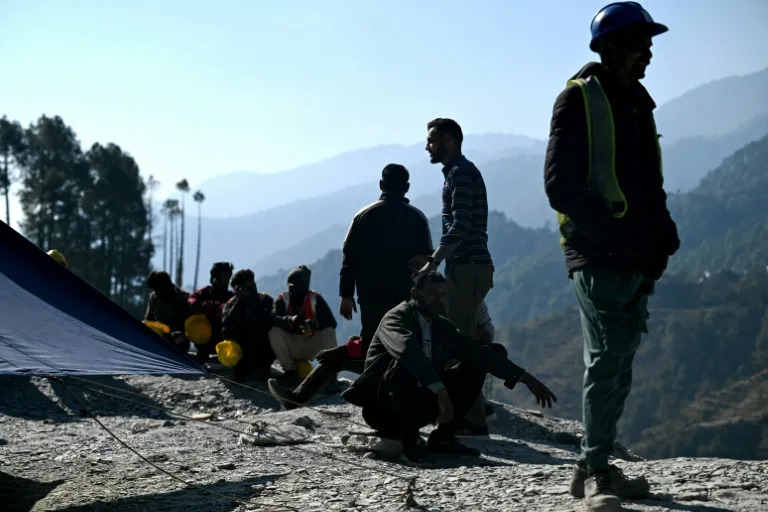
Rescue teams pause for a rest outside the tunnel entrance (Arun SANKAR)
Ambulances were on standby Thursday as Indian rescuers dug through the final metres of debris separating them from 41 workers trapped in a collapsed road tunnel for nearly two weeks.
Rescue teams have specially fitted stretchers with wheels, ready to pull the exhausted men out through 57 metres (187 feet) of steel pipe -- once it is driven through the final section of the tonnes of earth, concrete and rubble blocking their escape.
Emergency vehicles and a field hospital stood ready, preparing to receive the men who have been trapped since a portion of the under-construction tunnel in the Himalayan state of Uttarakhand caved in 12 days ago.
"We have done rehearsals on how to get people safely out," National Disaster Response Force chief Atul Karwal told reporters Thursday.
"The boys will go in first," he said. "We have put wheels under the stretchers so that when we go in, we can get the people out one by one on the stretcher -- we are prepared in every way."
But rescue efforts have been hit with repeated delays, including more debris falling, fears of further cave-ins and drilling machine breakdowns, as progress on Thursday was slowed by further mechanical problems.
- 'Himalayan geology is the enemy' -
"The 10 to 12 metres (32 to 39 feet) remaining... we don't know what can come up, but we are ready to handle it," Karwal said, adding that the trapped men were "keeping up their morale".
Uttarakhand chief minister Pushkar Singh Dhami said the work was on a "war footing", with a "team of doctors, ambulances, helicopters and a field hospital" set up.
Syed Ata Hasnain, a senior National Disaster Management Authority official, refused to say when the men might be freed.
"This is like battle," the retired general told reporters. "You cannot put a timeline on it. In battle, you don't know what the enemy is going to do.
"Here, the land is your enemy. Himalayan geology is the enemy... it is very challenging work."
Experts have warned about the impact of extensive construction in Uttarakhand, large parts of which are prone to landslides.
"The rescuers and the workers stuck inside are at equal risk," Hasnain added.
Arnold Dix, president of the International Tunnelling and Underground Space Association, told AFP while it was "not nice" the men were trapped, that fact they were safe was a "gift."
"Normally when I am responding to a rescue, there is some flooding or we're running out of oxygen or something terrible is happening," he said, noting the areas where the men were was stable.
- Prayers for safe release -
The area was a flurry of activity with worried relatives gathered outside the site, where a Hindu shrine has been erected, with a priest holding prayers for the safe rescue of the trapped men.
"The day they will come out of the tunnel, it will be the biggest, happiest day for us," said Chanchal Singh Bisht, 35, whose 24-year-old cousin Pushkar Singh Ary is trapped inside.
In case the route through the main tunnel entrance does not work, rescuers also started blasting and drilling from the far end of the unfinished tunnel, nearly half a kilometre (over a quarter of a mile) long.
Preparations have also been made for a risky vertical shaft directly above.
The workers were seen alive for the first time on Tuesday, peering into the lens of an endoscopic camera sent by rescuers down a thin pipe through which air, food, water and electricity are being delivered.
Though trapped, they have plenty of space, with the area inside 8.5 metres high and stretching about two kilometres in length.
The tunnel is part of Prime Minister Narendra Modi's infrastructure project aimed at cutting travel times between some of the most popular Hindu sites in the country, as well as improving access to strategic areas bordering rival China.
bur-pjm/leg/ash-pjm/bfm
Thu, November 23, 2023

Rescue teams pause for a rest outside the tunnel entrance (Arun SANKAR)
Ambulances were on standby Thursday as Indian rescuers dug through the final metres of debris separating them from 41 workers trapped in a collapsed road tunnel for nearly two weeks.
Rescue teams have specially fitted stretchers with wheels, ready to pull the exhausted men out through 57 metres (187 feet) of steel pipe -- once it is driven through the final section of the tonnes of earth, concrete and rubble blocking their escape.
Emergency vehicles and a field hospital stood ready, preparing to receive the men who have been trapped since a portion of the under-construction tunnel in the Himalayan state of Uttarakhand caved in 12 days ago.
"We have done rehearsals on how to get people safely out," National Disaster Response Force chief Atul Karwal told reporters Thursday.
"The boys will go in first," he said. "We have put wheels under the stretchers so that when we go in, we can get the people out one by one on the stretcher -- we are prepared in every way."
But rescue efforts have been hit with repeated delays, including more debris falling, fears of further cave-ins and drilling machine breakdowns, as progress on Thursday was slowed by further mechanical problems.
- 'Himalayan geology is the enemy' -
"The 10 to 12 metres (32 to 39 feet) remaining... we don't know what can come up, but we are ready to handle it," Karwal said, adding that the trapped men were "keeping up their morale".
Uttarakhand chief minister Pushkar Singh Dhami said the work was on a "war footing", with a "team of doctors, ambulances, helicopters and a field hospital" set up.
Syed Ata Hasnain, a senior National Disaster Management Authority official, refused to say when the men might be freed.
"This is like battle," the retired general told reporters. "You cannot put a timeline on it. In battle, you don't know what the enemy is going to do.
"Here, the land is your enemy. Himalayan geology is the enemy... it is very challenging work."
Experts have warned about the impact of extensive construction in Uttarakhand, large parts of which are prone to landslides.
"The rescuers and the workers stuck inside are at equal risk," Hasnain added.
Arnold Dix, president of the International Tunnelling and Underground Space Association, told AFP while it was "not nice" the men were trapped, that fact they were safe was a "gift."
"Normally when I am responding to a rescue, there is some flooding or we're running out of oxygen or something terrible is happening," he said, noting the areas where the men were was stable.
- Prayers for safe release -
The area was a flurry of activity with worried relatives gathered outside the site, where a Hindu shrine has been erected, with a priest holding prayers for the safe rescue of the trapped men.
"The day they will come out of the tunnel, it will be the biggest, happiest day for us," said Chanchal Singh Bisht, 35, whose 24-year-old cousin Pushkar Singh Ary is trapped inside.
In case the route through the main tunnel entrance does not work, rescuers also started blasting and drilling from the far end of the unfinished tunnel, nearly half a kilometre (over a quarter of a mile) long.
Preparations have also been made for a risky vertical shaft directly above.
The workers were seen alive for the first time on Tuesday, peering into the lens of an endoscopic camera sent by rescuers down a thin pipe through which air, food, water and electricity are being delivered.
Though trapped, they have plenty of space, with the area inside 8.5 metres high and stretching about two kilometres in length.
The tunnel is part of Prime Minister Narendra Modi's infrastructure project aimed at cutting travel times between some of the most popular Hindu sites in the country, as well as improving access to strategic areas bordering rival China.
bur-pjm/leg/ash-pjm/bfm
